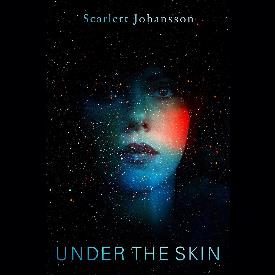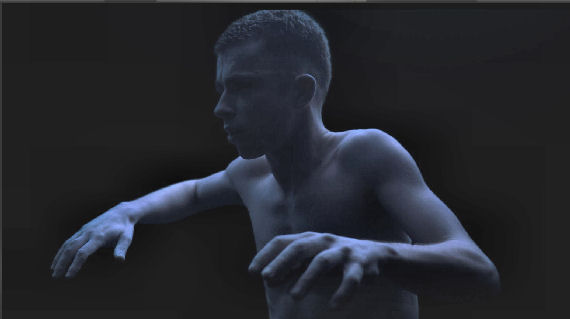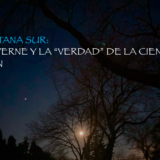The young actress (well, she’s 30 this year, which makes her young in my book; besides, I first noticed her in the film Eight-Legged Freaks [2002], playing a 15-or-so-year-old when she was really 18) is getting a lot of attention this year. Not only from Marvel fans; she’s played the Black Widow (Natasha Romanoff) in four Marvel movies (Iron Man 2—2010, The Avengers—2011, Captain America: The Winter Soldier—2014 and Avengers: Age of Ultron—in post-production now)—with a fifth eponymous (to her character) movie just announced (Black Widow); she’s also been in the hit movies Lucy, Chef, Her, Hitchcock, He’s Just Not That Into You, The Spirit, Vicky Cristina Barcelona, The Other Boleyn Girl, The Nanny Diaries, The Prestige, The Island, Girl with a Pearl Earring, Lost in Translation and North among others. She’s gained several Golden Globe nominations along the way.

So it’s not like she needed the work or anything. So why would she appear in an “artsy-fartsy” film like Under The Skin, in a role that had her mostly acting unemotional and detached for most of the movie? Could it be the director, Jonathan Glazer, whose main claim to fame previously was Sexy Beast (2000), with the highly-regarded actors Ray Winstone, Ben Kingsley and Ian McShane? Could it be the chance to parade around naked on screen, which she’s not really had the chance to do before? You tell me, because I’m at a loss. Maybe they offered her a boat-load of money or something.
Because if you read the DVD box, you’ll think this is a science fiction film; it says something about an alien masquerading as a human… hey, you had me at “Scarlett Johansson and alien,” guys! Because if you’re a pubertal- or post-pubertal male SF fan, those two words should make you want to view it. And if you look at some of the critical comments on line, you’ll see that Rotten Tomatoes gives it an 86% “fresh” (critics) but only 57% of the audience liked it; on Google, Rotten Tomatoes seems to be saying “Its message may prove elusive for some, but with absorbing imagery and a mesmerizing performance from Scarlett Johansson, Under the Skin is a haunting …” …no, it’s not. This is an art film, not a science fiction film.
What’s the difference? Well, according to dictionary.com, an art film is a “motion picture made primarily for aesthetic reasons rather than commercial profit, often of an experimental nature or having an unconventional or highly symbolic content, aimed typically at a limited audience.” A science fiction film, however—according to Wikipedia—is “a film genre that uses science fiction: speculative, fictional science-based depictions of phenomena that are not fully accepted by mainstream science, such as extraterrestrial life forms, alien worlds, extrasensory perception and time travel, along with futuristic elements such as spacecraft, robots, cyborgs, interstellar space travel or other technologies. Science fiction films have often been used to focus on political or social issues, and to explore philosophical issues like the human condition. In many cases, tropes derived from written science fiction may be used by filmmakers ignorant of or at best indifferent to the standards of scientific plausibility and plot logic to which written science fiction is traditionally held.”
Now, if you’ve seen this movie, that last line above really rings a bell. But let me talk a bit about what the film is—that is, what its content is. Briefly—although little in this movie is at all brief—it’s about an alien’s attempt to become human. Scarlett Johansson plays an alien who takes on a human being’s appearance, and lures single men to their doom.
The movie starts, like many art films, with an intensely long and boring title sequence: as soon as the raft of studio and distributor logos is finished, we see a black screen with the words “Film4 and BFI present”—this is at 30 seconds—“a film by Jonanathan Glazer” and “Scarlett Johansson” in white and then nothing—just a black screen—for a further two minutes. In a science fiction film, this time is usually used to let us know it’s an SF film, introduce the characters and/or setting, and begin engaging us with the mise en scène. Instead, at two minutes and 35 seconds, we see a point of light against the black. (In an art film, the audience is usually transfixed by this wonderful subtlety; in an SF film, half the audience will have already left the theatre.) The point of light eventually becomes some kind of lens; the lens parts come together slowly, and then a black lens on a white background becomes an eye, suddenly. Over the lens we hear a female voice making “buh-buh” noises, then as the lens becomes an eye the voice is reciting words, like “field… foal… foul.” We are finally treated to the film’s title—black on white, this time—at four minutes and fifteen seconds!

After that, we get a few scenes of darkness with a winding road running beside a river through low hills or foothills; a motorcycle is revealed running at high speed down this road until finally the driver pulls over behind a white van that’s parked on the verge on the left facing away from us. At that point we realize that the cyclist has been driving “the wrong way” on the road, so we must be somewhere like Britain. The cyclist dismounts, walks down the embankment away from the camera—disappearing into the darkness—and shortly reappears carring a limp body—wearing a jeans skirt and patterned stockings—over his shoulder. He opens the rear door of the van and begins to deposit the body inside. There is a cut—and we are suddenly looking at Scarlett’s face as she lies—apparently dead or unconscious—on a white, translucent surface; there is only indirect lighting and what is coming through the floor. A naked female is removing Scarlett’s skirt, top, shoes, stockings and underwear until Scarlett lies naked on this white floor; the other female figure begins donning the clothes she has taken off Scarlett and we suddenly realize that this figure is also Scarlett! The clothed Scarlett bends down and picks something off the naked Scarlett—a tear runs down the naked Scarlett’s face—and we realize that Scarlett has taken an ant off Scarlett’s body. There is a cut—typically, for an art film, very few scenes come to a proper conclusion; there are a million cuts instead.
We find Scarlett coming down the stairs of a very large block of what appears to be Council flats (see Attack the Block), and we cut away to the outside where the motorcyclist is removing his bike from the white van. Scarlett gets into the van, finds the key and both of them drive off. There is a cut, and we follow Scarlett down an escalator into a mall, where she apparently buys some makeup; we next see her sitting in the van applying some very red lipstick. The next several hours of the movie—I’m kidding; the movie’s only about an hour and forty minutes, although it appears longer—involve watching Scarlett’s character pick up lonely men and take them back to her room—various rooms in various buildings—where she entices them to take off their clothes by stripping down to her underwear as they walk. As she walks backwards, on a smooth, black floor, she is followed by these naked men who begin to walk downwards as if the black goo is water; they eventually disappear into the surface she walks comfortably on top of. She then puts her clothes back on and goes in search of other men. Eventually, we learn that they are in Scotland (specifically Glasgow, though I’m not sure how I knew that.)
At one point, to show that she is alien and has no human emotion at all, she “picks up” a Czech man who has been swimming in a wet suit in a rocky cove with a shingle shore; while she is talking to him, a couple that has been picnicking on the shingle notices their dog has been caught by the undertow. The woman leaves her husband to watch the baby while she swims out to help the dog, but she is soon overwhelmed by the waves; her husband swims out to help her. The Czech man dashes into the water to help him, rescuing him at great effort, but the man goes back in a futile attempt to save his wife; the baby is left alone—crying very loudly—on the shingle. The Czech, exhausted by his attempt, lies at the edge of the water. Scarlett goes up to him and we think she’s about to help him, but she picks up a rock and knocks him unconscious. She drags him—slowly—back to the van, ignoring the crying baby. It is after this that we learn the motorcycle man’s function: he’s the cleanup guy. He goes to the seashore, packing up the Czech guy’s tent and gear, leaving the wailing baby alone at the seashore in the gathering dark. This was the only really impactful scene in the movie. No human being could have ignored that child.

At about the second or third man we see “goo’d,” we find out that their bodies float in the goo, which is transparent like water from underneath, until the skin is suddenly emptied, and everything—skin, contents and all—goes down some kind of a conveyor belt into a red something. This continues until she picks up a man with extreme facial neurofibromatosis; a disfiguring disease like the Elephant Man’s. He is very socially awkward, but she convinces him to come back to her place. This time she fully undresses as the man comes toward her, and then there’s another cut, and rather than see this man disappear into the goo, we see him from the legs down coming out of the building followed by Scarlett. Did she weaken? Did the goo reject him because of his disfigurement? I haven’t read the book this is based on, so your guess is as good as mine. By the way, all the men she picks up are Glaswegian locals, filmed with a hidden camera—they weren’t (according to the IMDB bulletin board) told that they were in a movie until after.
If all this sounds tedious beyond belief—my descriptions are accurate—then you’re right. It is. It’s an art film—read “pretentious and overblown” using… what were those words? Oh, yes: “tropes derived from written science fiction may be used by filmmakers ignorant of or at best indifferent to the standards of scientific plausibility and plot logic to which written science fiction is traditionally held.”
Why are there aliens in Scotland? If they want meat, why only men? Why one at a time? How do they get the motorcycles and vans? And so on. There is no explanation for anything that happens in this movie, nor any reason—aside from the obvious attraction of seeing Ms. Johansson nude—to watch it, really.
And as far as her nudity; well, she’s a reasonably attractive movie person; like most straight men—and probably some other people as well—I am curious about what female movie stars look like without their clothes. Surprise! They look just like everyone else does without their clothes! Some are large, some are small; we all share certain physical qualities—male and female—that we keep under wraps for the most part. Our society has set up certain criteria that we use to determine who’s “attractive” and who’s not—whether it’s right or wrong, that’s just the way it has been for many, many years. She’s no Bo Derek (10) in terms of physical properties, but she is not as dumb as that actress portrayed herself, either—and I’ll take a smart, average-looking woman over a stupid “10” any day! Sometimes the physical properties are what first attract us, but they certainly aren’t everything that keeps us attracted! That being said, I suppose curiosity about Ms. Johansson’s physical form might be a reason for some people—especially adolescent males—to rent or stream the movie.
The director thinks he’s Stanley Kubrick, and attempts to do some Kubrick-like cinematography, which succeeds in some cases. But Kubrick’s Barry Lyndon, if memory serves, weighed in at three hours and had a plot, setting, characters—all of which were used to good purpose—and seemed shorter (it really was a movie that got kind of a bad rap; it’s not as boring as some think). This movie, at 108 minutes, seems three hours long. If you’re shocked by full-frontal nudity—both male and female—this will not be a movie you’ll want to see; if you’re shocked by bad filmmaking, likewise.

I guess what I’m trying to say is that this is a bad, boring film; Scarlett is given little chance to do any real acting, and in my mind it fails even as an art film. That’s all. Aside from the naked people, there’s really little of interest in the film, so I have fewer than usual pictures from it in this blog.
I welcome all comments, suggestions, brickbats, information, etc. from my readers. If you have anything at all to say—even if you want to tell me I’m wrong or have drawn the wrong conclusion (which does happen), please register and comment here; or comment on my Facebook page, or in the several Facebook groups where I publish a link to this column. I might thank you, I might argue, but at least we’re interacting. My opinion is, as always, my own, and doesn’t necessarily reflect the views of Amazing Stories or its owners, editors, publishers or other bloggers. See you next week!










